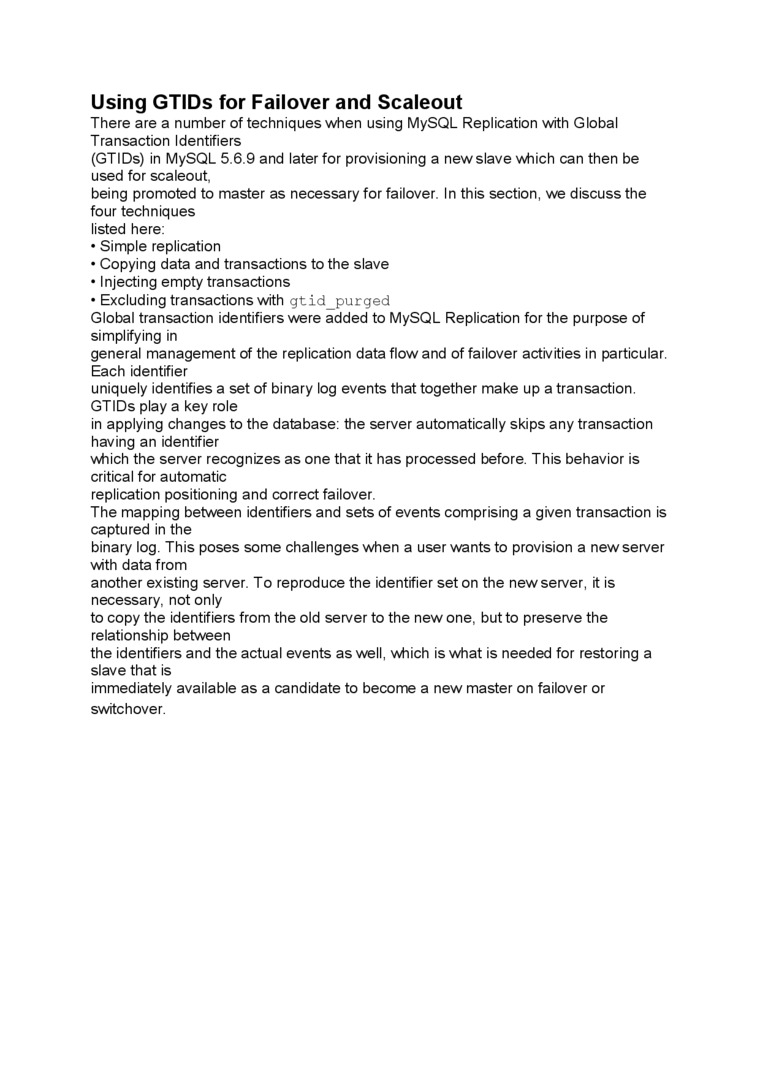89571

Using GTlDs for Failover and Scaleout
There are a number of techniques when using MySQL Replication with Global Transaction Identifiers
(GTlDs) in MySQL 5.6.9 and later for provisioning a newslave which can then be used for scaleout,
being promoted to master as necessary for failover. In this section, we discuss the four techniques listed here:
• Simple replication
• Copying data and transactions to the slave
• Injecting empty transactions
• Excluding transactions with gtid_purged
Global transaction identifiers were added to MySQL Replication for the purpose of simplifying in
generał management of the replication data flowand of failover activities in particular. Each identifier
uniquely identifies a set of binary log events that together make up a transaction. GTlDs play a key role
in applying changes to the database: the server automatically skips any transaction having an identifier
which the server recognizes as one that it has processed before. This behavior is critical for automatic
replication positioning and correct failover.
The mapping between identifiers and sets of events comprising a given transaction is captured in the
binary log. This poses some challenges when a user wants to provision a newserver with data from
another existing server. To reproduce the identifier set on the newserver, it is necessary, not only
to copy the identifiers from the old server to the new one, but to preserve the relationship between
the identifiers and the actual events as well, which is what is needed for restoring a slave that is
immediately available as a candidate to become a new master on failover or switchover.
Wyszukiwarka
Podobne podstrony:
Using MySQL and memcached with Ruby There are a number of different modules for interfacing to memca
Using MySQL Proxy There are a number of different ways to use MySQL Proxy. At the most basie level,
tape-recorded conversations. In excerpt (4), for instance, there are a number of markings which are
mbs 030 MY BKEATHING SYSTEM peaceful repose they are to look for liuppiness and strcngth during the
img2txt Many MATLAB toolboxes for małh and dała analysis are significanłly updałed in Release 12. En
physics and relashioships topic-specific vocabularyPhysical appearance Taik 2. There are loti of Eng
18 Waldemar Deluga 14 and Moldavia. There are several Moldavian editions illustrated with the e
Data types and sizes • There are only a few basie data types in C: - &
02 ML tlbx text Many MATLAB toolboxes for małh and dała analysis are significanłly updałed in R12. E
CSG264 Unit 21Possessive and Demonstrative Ad
A<YearableHardware improwment storę eon be o tneasure ttwe for ihe tuhrmunm leader. There&nb
individual lives; and there are pockets of severe deprivation within the United States) but the U.S.
46407 Picture 6 Flying Parts and Wings There are two types °t Wings: Those that are vertical to the
więcej podobnych podstron